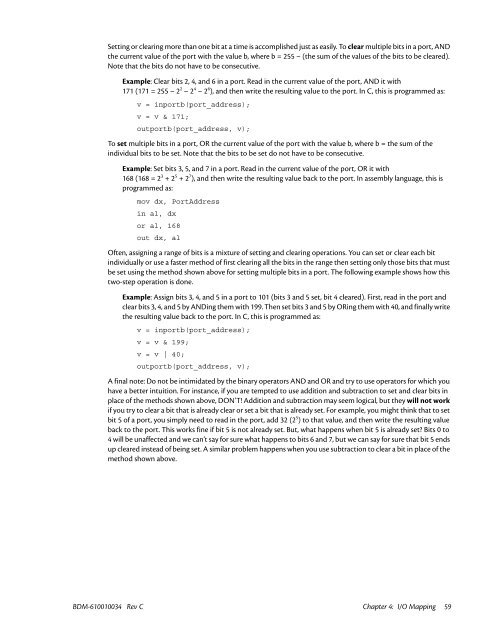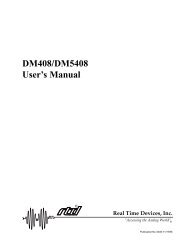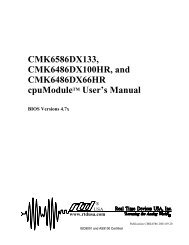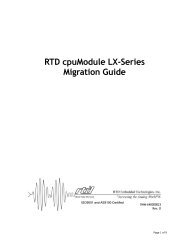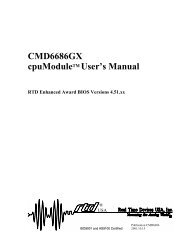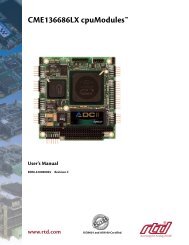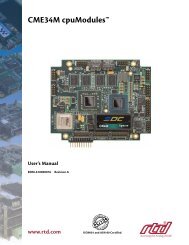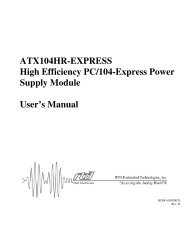Hardware Manual - RTD Embedded Technologies, Inc.
Hardware Manual - RTD Embedded Technologies, Inc.
Hardware Manual - RTD Embedded Technologies, Inc.
You also want an ePaper? Increase the reach of your titles
YUMPU automatically turns print PDFs into web optimized ePapers that Google loves.
Setting or clearing more than one bit at a time is accomplished just as easily. To clear multiple bits in a port, AND<br />
the current value of the port with the value b, where b = 255 – (the sum of the values of the bits to be cleared).<br />
Note that the bits do not have to be consecutive.<br />
Example: Clear bits 2, 4, and 6 in a port. Read in the current value of the port, AND it with<br />
171 (171 = 255 – 2 2 – 2 4 – 2 6 ), and then write the resulting value to the port. In C, this is programmed as:<br />
v = inportb(port_address);<br />
v = v & 171;<br />
outportb(port_address, v);<br />
To set multiple bits in a port, OR the current value of the port with the value b, where b = the sum of the<br />
individual bits to be set. Note that the bits to be set do not have to be consecutive.<br />
Example: Set bits 3, 5, and 7 in a port. Read in the current value of the port, OR it with<br />
168 (168 = 2 3 + 2 5 + 2 7 ), and then write the resulting value back to the port. In assembly language, this is<br />
programmed as:<br />
mov dx, PortAddress<br />
in al, dx<br />
or al, 168<br />
out dx, al<br />
Often, assigning a range of bits is a mixture of setting and clearing operations. You can set or clear each bit<br />
individually or use a faster method of first clearing all the bits in the range then setting only those bits that must<br />
be set using the method shown above for setting multiple bits in a port. The following example shows how this<br />
two-step operation is done.<br />
Example: Assign bits 3, 4, and 5 in a port to 101 (bits 3 and 5 set, bit 4 cleared). First, read in the port and<br />
clear bits 3, 4, and 5 by ANDing them with 199. Then set bits 3 and 5 by ORing them with 40, and finally write<br />
the resulting value back to the port. In C, this is programmed as:<br />
v = inportb(port_address);<br />
v = v & 199;<br />
v = v | 40;<br />
outportb(port_address, v);<br />
A final note: Do not be intimidated by the binary operators AND and OR and try to use operators for which you<br />
have a better intuition. For instance, if you are tempted to use addition and subtraction to set and clear bits in<br />
place of the methods shown above, DON’T! Addition and subtraction may seem logical, but they will not work<br />
if you try to clear a bit that is already clear or set a bit that is already set. For example, you might think that to set<br />
bit 5 of a port, you simply need to read in the port, add 32 (2 5 ) to that value, and then write the resulting value<br />
back to the port. This works fine if bit 5 is not already set. But, what happens when bit 5 is already set? Bits 0 to<br />
4 will be unaffected and we can’t say for sure what happens to bits 6 and 7, but we can say for sure that bit 5 ends<br />
up cleared instead of being set. A similar problem happens when you use subtraction to clear a bit in place of the<br />
method shown above.<br />
BDM-610010034 Rev C Chapter 4: I/O Mapping 59


